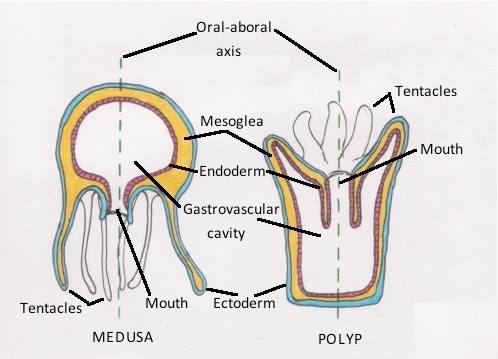Evolution & Systematics
Within the phylum Cnidaria, there are over 9,000 known species (Ruppert et al. 2004; Soares et al. 2011). Despite the jelly-like consistency of organisms in this phylum, there is an extensive fossil record, going as far back as the Precambrian period (Ruppert et al. 2004). Several features distinguish organisms in the phylum Cnidaria from other phyla. In general terms, Cnidarians follow a body plan consisting of a large body cavity (the coelenteron), and two tissue layers: the outer layer (epidermis) and an inner layer, called the gastrodermis (Mather & Bennett 1994; Ruppert et al. 2004).

|
Diagram of general Cnidarian body plans, for medusoid and polypoid organisms, both showing radial symmetry.
Adapted from Ruppert et al. (2004). |
Radial symmetry has allowed organisms in this phylum to receive information about their surroundings from all directions (Mather & Bennett 1994; Ruppert et al. 2004), which is important since they feed opportunistically on plankton and other microscopic fauna in the water surrounding them.
Cnidarians have a complex life cycle, with two main body forms: polypoid and medusoid (Mather & Bennett 1994; Ruppert et al. 2004), and they have the ability to be either solitary or colonial (Gosliner et al. 1996; Mather & Bennett 1994; Ruppert et al. 2004). In polypoid body form, tentacles surrounding the mouth face upwards, whereas in medusoid forms tentacles face downward in relation to the rest of the body (Gosliner et al. 1996; Mather & Bennett 1994; Ruppert et al. 2004).
Within the phylum Cnidaria, there are several classes: Scyphozoa, Hydrozoa and Anthozoa. The organism outlined on this webpage falls into the class Anthozoa, in the order Zoantharia. Anthozoan organisms differ from other Cnidarian classes in several ways. Firstly, there are partitions in the body cavity, called mesenteries (Mather & Bennett 1994; Reft & Daly 2012; Ruppert et al. 2004). They also completely lack the medusa stage in their life cycle, remaining sessile and attached to substrate (Gosliner et al. 1996; Mather & Bennett 1994; Ruppert et al. 2004), and are the only class to possess all three types of cnidocyte cells (Ruppert et al. 2004). It has been suggested that this class is not a monophyletic group (Gosliner et al. 1996), and that it has been poorly researched as a whole (Mather & Bennett 1994; Reimer et al. 2006; Ryland & Babcock 1991; Soares et al. 2011).

|
Diagram illustrating mesenteries inside Anthozoan polyps.
Adapted from Ryland & Lancaster (2003). |
Species within the subclass Zoantharia have their tentacles in multiples of six (Mather & Bennett 1994), and within the order Zoanthidea, the genera Palythoa and Protopalythoa have been shown to be very closely related, through use of molecular markers (Reimer et al. 2007).
Results from the study by Reimer et al. (2006) suggested that many of the species that have been classed as either Palythoa or Protopalythoa are more than likely just different morphotypes of the same species, due to molecular markers (cytochrome oxidase 1 (CO1) and 16S ribosomal DNA (16S rDNA)) showing that the two ‘genera’ are in fact one monophyletic group, with no clade evident between them (Reimer et al. 2006).
This has lead to the debate of whether the two genera should be combined into a single genus “Palythoa”. |